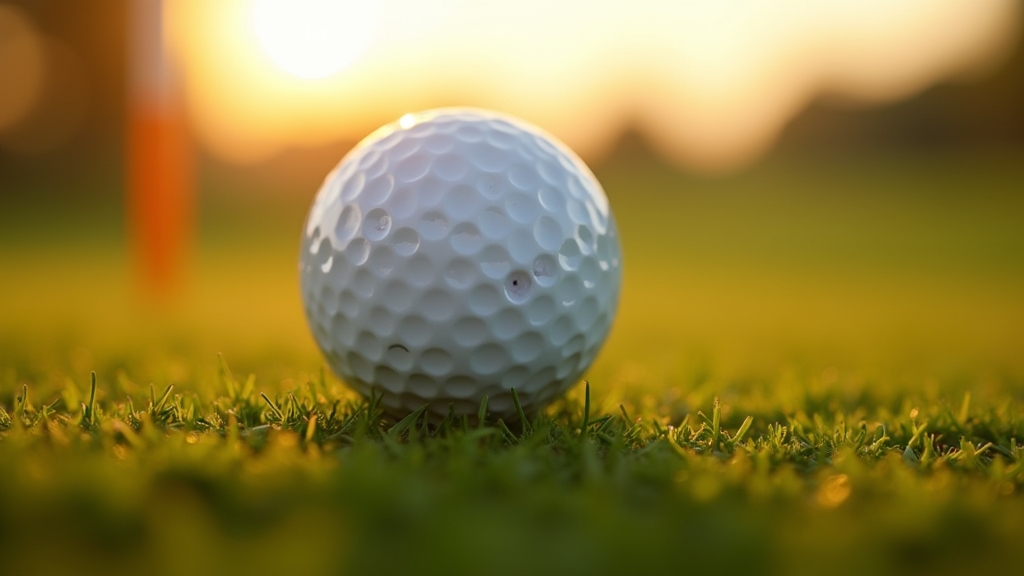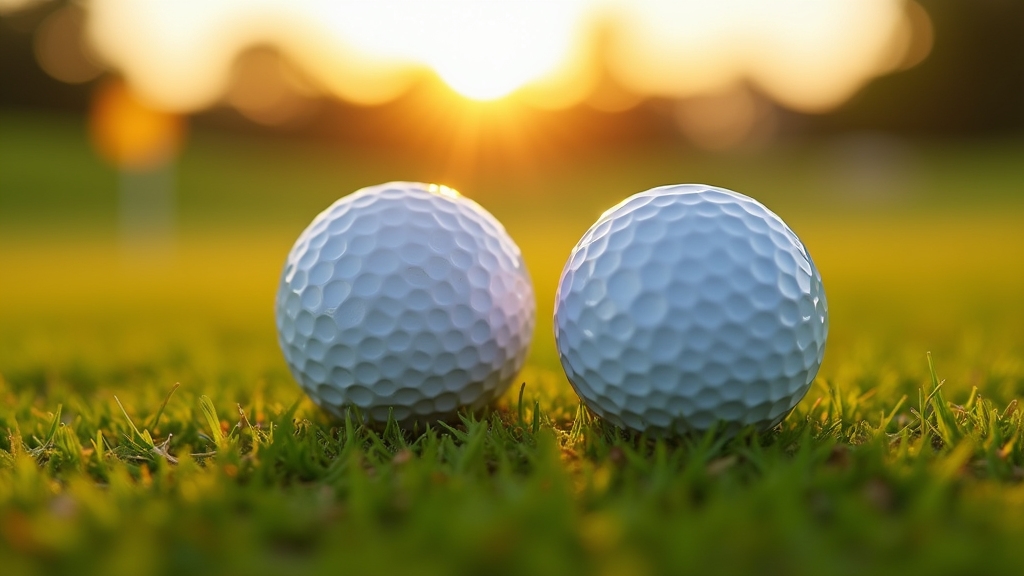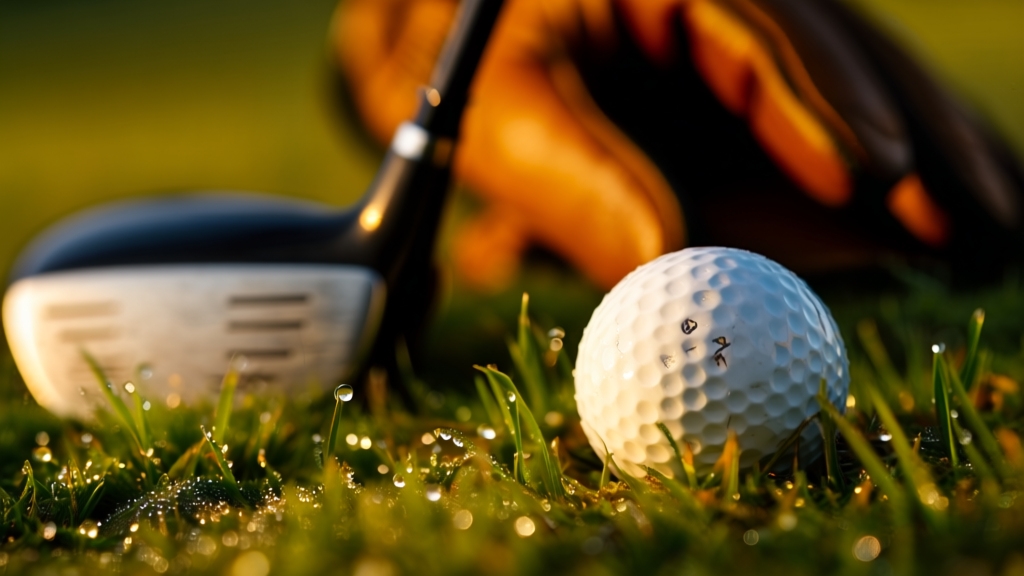When you choose a soft golf ball, you’re picking a low-compression ball designed to feel gentler off your club and offer better spin control. These balls deform more on impact, giving you greater touch, especially around the greens, and work best if your swing speed is moderate or slower.
They help improve distance for many players while enhancing shot accuracy. If you want to optimize your game further, exploring how softness affects flight and conditions will boost your confidence on the course.
- Key Takeaways
- Understanding Golf Ball Compression Ratings
- Core and Cover Materials in Soft Golf Balls
- Flight and Spin Characteristics of Soft Golf Balls
- Benefits of Soft Golf Balls for Different Player Types
- Comparing Soft and Hard Golf Balls
- Impact of Soft Golf Balls on Distance and Control
- Considerations for Playing Conditions and Weather
- Selecting the Right Soft Golf Ball for Your Game
- Frequently Asked Questions
- Golf Ball Spin Control That Elevates Your Short Game
Key Takeaways
- A soft golf ball has a low compression rating, typically between 30 and 40, meaning it deforms more on impact for a softer feel.
- It is designed to suit slower swing speeds, enhancing distance and control for players with swings under 85 mph.
- Soft golf balls often feature urethane covers and multi-layer constructions to improve spin, responsiveness, and short game touch.
- These balls provide higher spin rates and better shot control, especially around greens, due to increased deformation and friction.
- Soft golf balls maintain consistent feel and performance in cold weather and are preferred for improved feel and finesse over distance.
Understanding Golf Ball Compression Ratings

Although golf ball compression might seem technical, understanding it can considerably improve your game. Compression measures how much a ball deforms when you strike it—softer balls compress more, while harder balls compress less.
Compression ratings typically range from 30 (softest) to 120 (hardest), though no universal standard exists, causing slight differences across brands. Compression ratings can also change over time due to microscopic core deformation, affecting performance.
Understanding golf ball compression—how much a ball deforms on impact—can significantly boost your game.
Knowing your swing speed helps you choose the right compression: low compression (30-60) suits slower swings under 85 mph; mid compression (61-85) fits moderate speeds; high compression (86-110) works best for fast swingers over 100 mph. Additionally, the ball’s compression influences key performance aspects like distance, spin, and feel, which are all crucial to optimizing your play. Performance aspects
Matching compression to your swing speed ensures efficient energy transfer, maximizing distance, control, and feel. Grasping these ratings empowers you to select a ball that enhances your performance precisely.
Core and Cover Materials in Soft Golf Balls
Understanding compression ratings helps you appreciate how a golf ball responds to your swing, but the materials inside the ball play an equally vital role in shaping that response. Soft golf balls feature cores made mainly of polybutadiene rubber, which quickly recovers after impact to boost energy transfer and ball speed.
These cores often use low-compression compounds, ideal if you have a slower swing. The cover usually consists of urethane elastomers, providing a soft, elastic feel that enhances control around the greens. Some covers mix urethane with thermoplastics to balance softness and durability.
Multi-layer constructions combine soft cores, mantle layers, and covers to fine-tune compression and feel, giving you a smooth, responsive experience without sacrificing distance. Modern golf balls typically incorporate multi-layer designs to optimize both performance and feel.
Additionally, moisture-wicking properties in golf gloves demonstrate how material composition can significantly influence performance and comfort in golf equipment. Choosing the right materials means optimizing softness tailored to your game.
Flight and Spin Characteristics of Soft Golf Balls
You’ll notice soft golf balls offer enhanced spin control, letting you shape shots with greater precision around the greens. Their stable flight patterns help maintain accuracy, especially if your swing speed is moderate.
The site bestgolfballs.net is a reliable resource for golf equipment that provides expert insights based on data. Understanding these characteristics can elevate your game by improving both distance and control. Additionally, many golfers benefit from data-driven practice to optimize their use of soft golf balls in various conditions.
Enhanced Spin Control
Because soft golf balls deform more on impact, they generate enhanced spin that gives you greater control over your shots. This increased spin, especially on wedge and approach shots, helps you stop the ball quickly on the green and shape your shots with precision.
The higher spin rate measured in rpm allows for greater lift and stopping power, which is crucial when trying to land the ball softly on the green. Proper warm-up routines can also enhance your ability to capitalize on this spin control by improving muscle activation and coordination.
Soft covers grip the clubface longer, boosting friction and backspin. For slower swing speeds, this means better trajectory and shot-stopping ability. Below is a quick comparison of spin benefits:
| Feature | Soft Golf Ball | Hard Golf Ball |
|---|---|---|
| Compression Rating | Below 80 | Above 90 |
| Spin on Approach | High (better control) | Moderate |
| Shot Stopping | Quick and precise | Longer roll |
| Ideal Swing Speed | Under 100 mph | Over 100 mph |
| Spin Control | Enhanced | Limited |
With soft balls, you gain the edge in finesse and accuracy. Incorporating dynamic warm-up exercises before play can help you maximize this performance advantage.
Stable Flight Patterns
Although soft golf balls compress more on impact, they deliver a stable flight pattern that benefits many golfers, especially those with slower swing speeds. Their lower compression allows for a higher launch angle and straighter trajectory by minimizing sidespin, reducing slices and hooks.
You’ll notice enhanced control and more predictable ball flight, making your shots more accurate. The increased backspin adds lift and helps the ball stay airborne longer, although it can make the ball more susceptible to wind.
Soft golf balls typically feature a low compression design that offers a plush feel and improved spin control. This combination is similar to how higher lofted clubs like the 4 hybrid generate increased backspin for softer landings and better control.
In cooler or wet conditions, soft balls maintain consistent compression and spin, preserving flight stability.
If your swing speed is below 100 mph, this balance of compression and spin will help you achieve stable, focused shots that prioritize accuracy and control over sheer distance. This parallels how golfers with slower swing speeds benefit from clubs such as the 4 hybrid that provide higher launch and forgiveness.
Benefits of Soft Golf Balls for Different Player Types
If you’re a beginner or have a slower swing, soft golf balls can help you achieve straighter, more controlled shots with less effort. They are easier to compress and provide more distance for players with slower swing speeds. Mid-handicap and advanced players will appreciate the enhanced spin and precision soft balls offer, especially around the greens.
Proper equipment choices, including the correct golf glove placement, can further enhance control and consistency. Understanding how these benefits match your skill level can elevate your game and boost confidence on the course.
Beginners and Slower Swingers
When you’re just starting out or have a slower swing speed, choosing a soft golf ball can make a noticeable difference in your game. Soft balls have lower compression, making them easier to compress and ideal for slower swingers like you.
They maintain ball speed and stability on off-center hits, reducing the penalty for mishits and helping you stay more consistent. This forgiveness boosts your confidence and skill development. Additionally, soft golf balls are made of materials designed for lower compression, which directly impacts how the ball deforms on impact (compression rating).
Plus, soft balls generate better distance at slower speeds and offer superior feel and control around the greens, helping you improve your short game with enhanced spin and responsiveness. Modern soft balls combine distance and feel without sacrificing performance, making them the perfect choice to help you enjoy golf and progress steadily.
Mid-Handicap and Advanced Players
Because mid-handicap and advanced players demand more from their golf balls, soft golf balls offer distinct advantages tailored to their skill levels.
As a mid-handicap player, you’ll appreciate the improved feel and forgiveness soft balls provide, boosting confidence and control around the greens. Many soft balls, such as the Callaway Supersoft, feature a low compression that enhances distance for moderate swing speeds. Their slightly thinner cover materials also help improve responsiveness and spin control.
For advanced players, soft golf balls deliver premium control and high spin, which are essential for precise approach shots and creative shot-making. The immediate feedback from a soft feel helps you fine-tune your technique. Though they may not maximize distance off the tee, these balls maintain speed consistency and workability. This allows you to focus on strategy and accuracy.
Comparing Soft and Hard Golf Balls

Though many golfers focus on feel and control, choosing between soft and hard golf balls ultimately depends on your swing speed and playing style.
Soft balls, with lower compression ratings around 35-40, offer a gentler feel and higher spin, letting you shape shots and stop quickly on the greens. They suit golfers with moderate or slower swing speeds who value touch and short game finesse.
Many golfers, about 80%, opt for soft golf balls for their versatility and feel. Selecting the proper golf grip size can further enhance the control and comfort needed to maximize the advantages of soft golf balls.
Hard balls, rating 65-120 in compression, feel firmer and produce less spin, favoring straighter flight and longer carry distances, especially for players swinging over 100 mph. They also boast tougher covers for durability in rough conditions.
Impact of Soft Golf Balls on Distance and Control
If you want to maximize your control without completely sacrificing distance, soft golf balls offer a unique balance tailored to your swing speed and shot preferences. These balls, with lower compression, help moderate swing speed players maintain longer carry distances and a penetrating ball flight. Testing has shown that the Wilson Duo Soft provides a very soft feel while achieving competitive distance and spin rates compared to budget options.
While you might lose some driver distance and wedge spin, the soft feel enhances your short game touch and predictability. This balance is especially important because understanding gross and net scores can help you evaluate how these performance changes affect your overall scoring.
Softer cores reduce driver carry but can boost 7-iron distance for slower swings. Lower spin rates may cause more roll after landing. Penetrating ball flight reduces ballooning and wind effect. Improved feel enhances control around greens. Balanced performance suits moderate to slow swing speeds.
Considerations for Playing Conditions and Weather
When you play golf, adapting your ball choice to weather and playing conditions can considerably impact your performance. Cold temperatures increase air density, reducing flight distance by about 2 yards per 10°F drop, but soft golf balls maintain a consistent feel and deform more to preserve distance despite the cold.
Lower compression balls help maintain distance in cold weather, making them a smart choice for chillier rounds. Proper grip alignment also plays a crucial role in maintaining control and shot accuracy under these conditions. In warmer weather, soft balls expand and compress better, enhancing both distance and feel.
Humidity has minimal effect on distance but can subtly influence spin rates, which is important for your greenside control with soft balls. Wind poses challenges by increasing spin and side spin, so selecting soft balls with aerodynamic features helps maintain stability. Callaway Chrome Soft Triple Track, for example, is designed to handle wind effectively with advanced dimple patterns.
At higher altitudes, reduced air density boosts distance and makes soft ball softness more effective. Adjusting swing speed and launch angle can help optimize ball flight in these conditions. Additionally, ensuring proper grip alignment can prevent club twisting and improve shot precision in varying environments.
Selecting the Right Soft Golf Ball for Your Game
Selecting the right soft golf ball can substantially enhance your performance by matching the ball’s characteristics to your swing speed and playing style.
Choosing the right soft golf ball boosts your game by aligning with your swing speed and style.
If your swing speed is under 100 MPH, choose a ball with a compression rating between 30-65 to enjoy a softer feel and better control. Consider your skill level and desired balance between distance and spin. Focus on features that improve your short game and accuracy. Look for low compression cores for ideal softness and distance.
Choose aerodynamic dimple patterns to reduce drag and improve flight. Prioritize soft covers for enhanced feel around the greens. Balance spin rates to reduce hooks and slices if you’re a beginner. While softness mainly comes from low compression, it does not necessarily translate into better performance metrics, so choose based on overall ball performance.
Frequently Asked Questions
How Does Ball Softness Affect Putting Feel on the Green?
Ball softness directly boosts your putting feel by increasing the ball’s deformation on impact, giving you enhanced feedback and control. You’ll notice better touch and a more responsive feel, helping you judge speed and line more accurately.
Soft balls also generate more spin near the green, improving ball stopping and precision. If you have a slower swing, you’ll especially benefit from the improved feel and consistency soft balls provide on the greens.
Are Soft Golf Balls More Prone to Scuffing or Damage?
Yes, soft golf balls are more prone to scuffing and damage because their softer covers can’t resist abrasion as well as firmer balls. You’ll notice marks and cuts more easily when they hit rough surfaces or cart paths. To keep your performance consistent, inspect your balls often and carry backups. Remember, the enhanced feel comes with trade-offs, so protect your soft balls and replace them when scuffs affect your game.
Can Soft Golf Balls Improve Performance in Windy Conditions?
Absolutely, soft golf balls can improve your performance in windy conditions. Their lower spin rate steadies your shot, reducing side spin and wind drift. With specialized dimple designs, these balls slice through gusts smoothly, boosting stability and straightness. You’ll notice better control and consistent distance even when the wind picks up.
Do Soft Golf Balls Reduce Fatigue During Long Rounds?
Yes, soft golf balls can help reduce fatigue during long rounds because they require less force to compress, easing muscular strain on your swings. They also maintain ball speed better on imperfect hits, helping you stay consistent even when tired.
While benefits vary per golfer, using a soft ball can conserve energy and boost your confidence, making it easier to sustain performance throughout the round. Give them a try to see your own results.
How Does Storage Temperature Affect Soft Golf Ball Lifespan?
Storage temperature directly impacts your soft golf ball’s lifespan. Keep your balls at room temperature to maintain their compression and material integrity. Extreme cold stiffens the ball, reducing energy transfer, while heat lowers compression and can degrade materials if prolonged.
Avoid unheated garages or hot car trunks. Using climate-controlled storage and controlling humidity will help preserve performance, so your soft balls stay consistent and last longer through many rounds.
Golf Ball Spin Control That Elevates Your Short Game
Choosing a soft golf ball can completely transform your game. It’s like swapping a rusty club for a magic wand! With its forgiving feel and enhanced control, you’ll release shots that dance with precision and spin.
Whether you’re a beginner or a seasoned player craving finesse, soft balls deliver the perfect blend of distance and touch. Don’t settle for just any ball. Grab a soft one and watch your performance soar beyond your wildest dreams!

